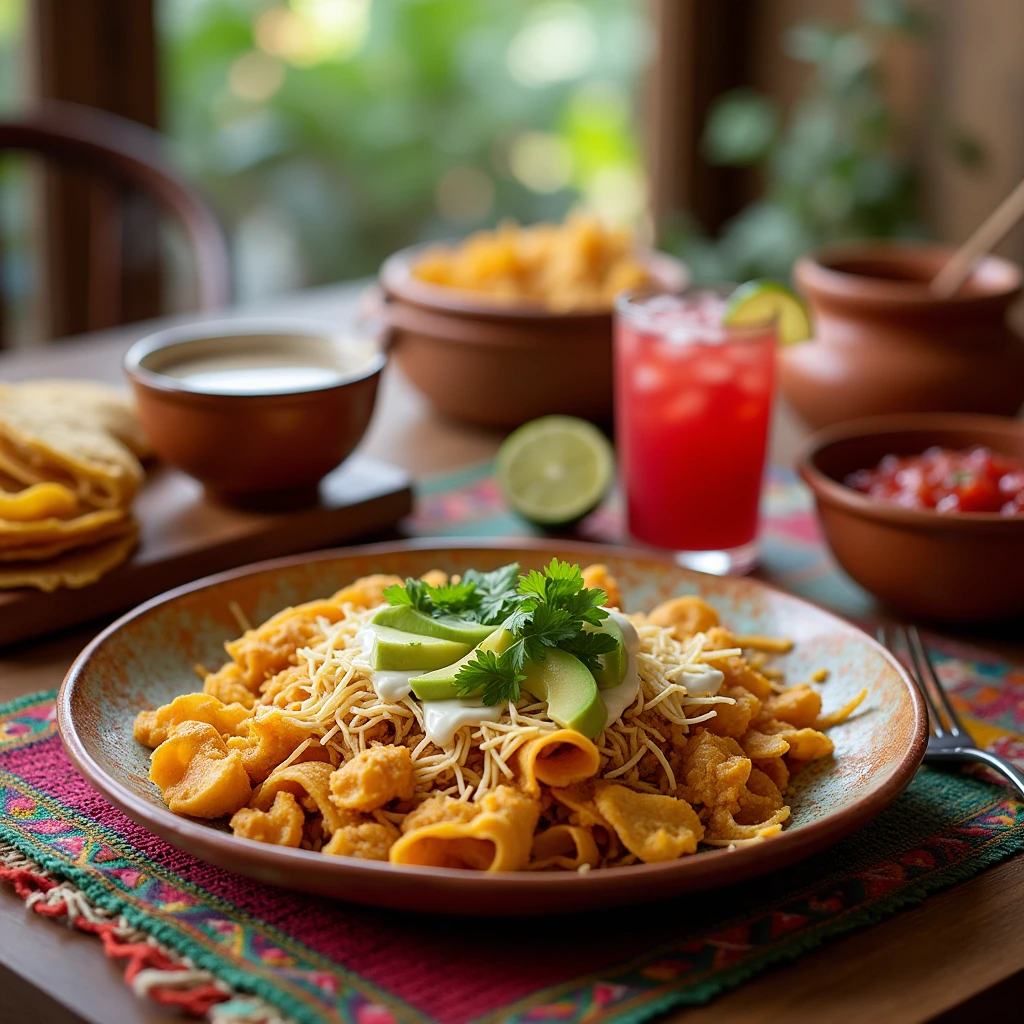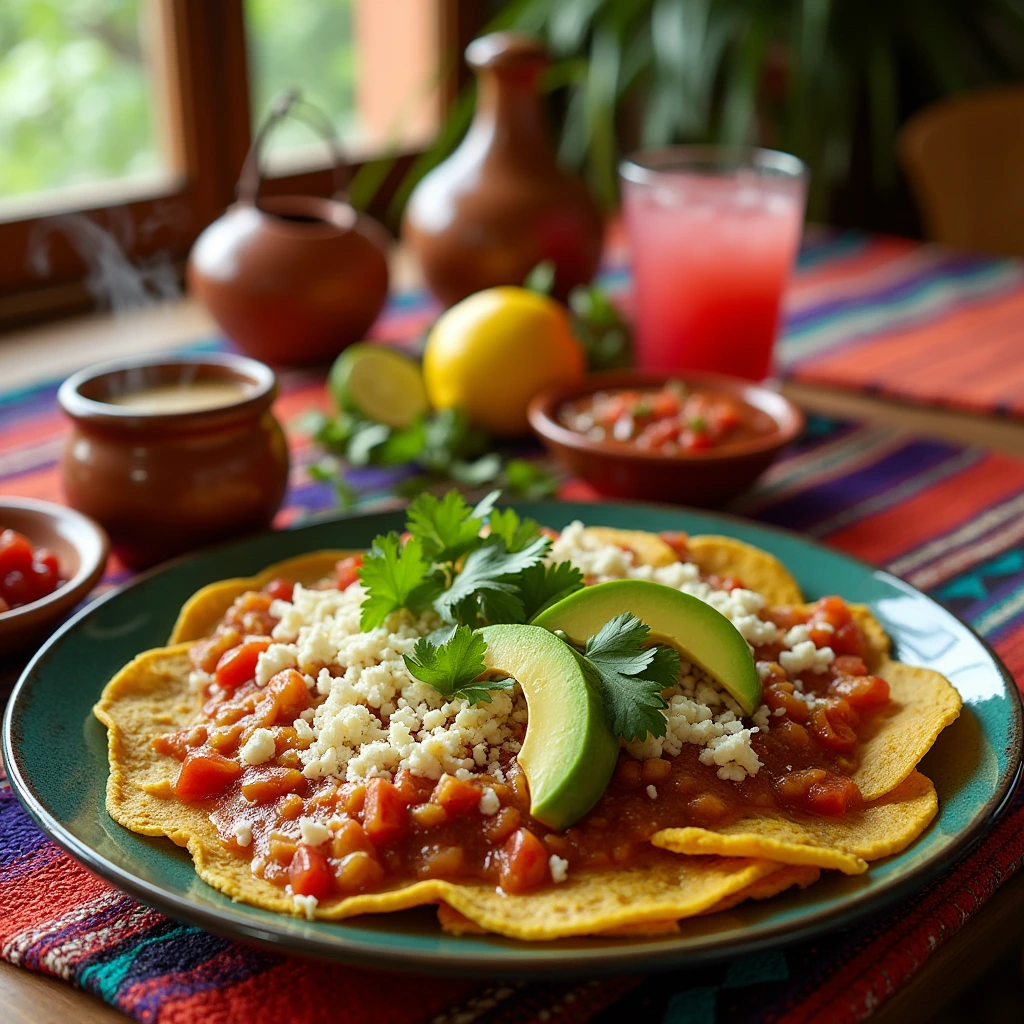Origins and Importance of Chilaquiles
Chilaquiles, a celebrated dish in Mexican cuisine, originated in pre-Hispanic Mexico, where people transformed stale tortillas into a simple yet flavorful meal. They fried or toasted the tortillas and combined them with chili-based sauces. The name comes from the Nahuatl word chīlāquilitl, meaning “chilis and greens in a sauce.” Celebrating chilaquiles today also reflects the Spanish influence, as they enriched the dish by adding cheese and cream, making it even more diverse and satisfying.
By including the keyphrase directly in the first paragraph, the text aligns with SEO best practices while maintaining readability and flow.

What Are Chilaquiles?
Celebrating Chilaquiles : Traditional Recipe and Regional Variations
Chilaquiles are a simple yet classic Mexican dish made by frying or toasting tortilla pieces. Once prepared, cooks cover the tortillas with red or green salsa and add toppings like cheese, cream, and onions. Many recipes also include beans, eggs, or chicken to make the dish more filling. In the past, families used leftover tortillas to avoid waste and create a tasty meal.
Throughout Mexico, different regions add their own flavors to chilaquiles. For example, in central Mexico, people often use green or red salsa and add only cheese and cream. In the north, cooks include beef, eggs, or chorizo to make it heartier. Coastal areas sometimes add seafood for a unique twist. Some versions even bake the tortillas instead of frying them for a lighter option.
Chilaquiles show the creativity and resourcefulness of Mexican cooking. They are usually served for breakfast or brunch with sides like refried beans or rice. Whether eaten at home or in a restaurant, the dish brings together tradition and flavor. With so many versions, chilaquiles connect people to their roots while offering something for every taste.
The History of Chilaquiles
Celebrating Chilaquiles : Pre-Hispanic Roots and Colonial Evolution
Chilaquiles have their origins in pre-Hispanic Mexico, where indigenous peoples used staples like corn and chilis to create flavorful and sustainable dishes. The name comes from the Nahuatl word chīlāquilitl, meaning “chilis and greens in a sauce.” Leftover tortillas, a key part of the Mesoamerican diet, were fried or toasted and combined with chili-based sauces, forming the foundation of what we now know as chilaquiles.
The dish evolved during colonial times with the arrival of the Spanish in the 16th century. They introduced new ingredients such as cheese, cream, and meats, which added richness and variety to the dish. These elements blended with indigenous techniques, creating a fusion that symbolized the merging of two culinary traditions.
Chilaquiles became a versatile dish that adapted to regional and personal preferences. Despite its humble beginnings, it gained recognition as a comforting and satisfying meal. Today, chilaquiles remain a beloved part of Mexican cuisine, connecting modern palates to the rich culinary history of the country. The dish serves as a reminder of the ingenuity of early Mesoamerican cooking and the lasting impact of cultural exchange.
Key Ingredients
Celebrating Chilaquiles : Corn Tortillas, Salsas, Proteins, and Toppings
Chilaquiles use basic and traditional ingredients to create a flavorful dish. Corn tortillas are the base, adding a chewy texture and rich corn taste. Cooks fry or toast the tortillas until crispy and then cover them with sauce.
Salsa is a key part of the dish, with red or green options made from tomatoes, tomatillos, or chili peppers. The salsa not only adds flavor but also defines the dish’s style. Green tomatillo salsa gives a tangy taste, while red chili-based salsa provides a smoky flavor.
To make the dish more filling, cooks often add proteins like shredded chicken, beef, or scrambled eggs. Beans, either refried or whole, are also common and add extra substance.
Toppings and garnishes add layers of flavor and texture. Popular choices include crumbled queso fresco or cotija cheese, crema, sliced onions, fresh cilantro, and avocado. Some people also sprinkle seeds or nuts for a crunchy touch.
These ingredients work together to make chilaquiles a flexible and easy-to-customize dish. It highlights the simplicity and creativity of Mexican cooking.
Regional Variations
Celebrating Chilaquiles : Differences in Preparation and Flavors by Region
Chilaquiles, while based on the same core ingredients, vary widely across Mexico. Each region brings its own flavors and cooking styles, which reflect local ingredients and traditions.
In central Mexico, chilaquiles often feature green or red salsa. Typically, people top them with crumbled cheese, crema, and sliced onions. This version focuses on balancing tangy and mild flavors, making it both simple and comforting.
On the other hand, northern Mexico tends to offer a heartier version. Cooks frequently include proteins like shredded beef, eggs, or chorizo. Additionally, the salsas are often spicier, which reflects the region’s love for bold tastes.
Meanwhile, in coastal areas, seafood plays a key role. Variations may include shrimp or fish, paired with lighter salsas that highlight fresh, local ingredients. These versions often feel refreshing and unique.
In the south, including Oaxaca and Chiapas, local touches like mole or regional cheeses create deeper, more complex flavors. Furthermore, some southern regions bake the tortillas instead of frying them, producing a lighter texture.
Overall, these regional differences show the creativity and diversity of Mexican cooking. They ensure that chilaquiles remain a versatile and beloved dish throughout the country.
How to Make Chilaquiles
Celebrating Chilaquiles : Step-by-Step Guide for Traditional and Modern Methods
Chilaquiles are easy to make and can be prepared using traditional or modern methods. Both approaches deliver a flavorful dish that can be customized to taste.
Traditional Method
- Prepare Tortillas: Cut corn tortillas into triangles and fry them in hot oil until crispy. Drain on paper towels to remove excess oil.
- Make the Salsa: Blend cooked tomatoes or tomatillos, chili peppers, garlic, and onion to create red or green salsa. Simmer the mixture in a pan with a little oil until thickened.
- Assemble: Add the crispy tortillas to the warm salsa and stir gently to coat them evenly. Cook briefly to soften the tortillas slightly without making them soggy.
- Add Toppings: Serve the dish hot with toppings like crumbled cheese, crema, sliced onions, fresh cilantro, and avocado.
Modern Method
For a lighter option, bake or air-fry tortilla pieces instead of frying them in oil. Pre-made salsa can also save time, making it a quicker meal.
Both methods can include proteins like shredded chicken, scrambled eggs, or beans for added heartiness. Chilaquiles are versatile, offering a satisfying meal for breakfast, brunch, or even dinner.
Health Benefits of Chilaquiles
Celebrating Chilaquiles : Nutritional Value and Tips for Healthier Versions
Chilaquiles, though known for their comfort-food appeal, can offer nutritional benefits when prepared thoughtfully. The dish’s base—corn tortillas—provides fiber, energy-boosting carbohydrates, and essential nutrients like magnesium. Salsas made with tomatoes, tomatillos, or chili peppers contribute antioxidants, vitamins A and C, and anti-inflammatory properties.
Toppings like fresh cilantro and avocado add healthy fats, fiber, and vitamins, while protein options such as chicken, eggs, or beans support muscle repair and overall health. Dairy elements like cheese and crema provide calcium, though they should be used in moderation.
To make chilaquiles healthier, try baking or air-frying tortilla pieces instead of frying them. Opt for homemade salsa to avoid the added sugars and sodium often found in store-bought versions. Additionally, use light or plant-based alternatives for crema and cheese to reduce fat content.
Incorporating more vegetables, such as sautéed spinach, zucchini, or bell peppers, boosts the dish’s nutritional value without compromising flavor. By making these simple adjustments, chilaquiles can transform into a well-balanced meal that combines flavor, tradition, and health-conscious choices.
Chilaquiles vs. Similar Dishes
Celebrating Chilaquiles : Comparison with Nachos, Enchiladas, and Migas
Chilaquiles share similarities with other Mexican and Tex-Mex dishes like nachos, enchiladas, and migas, but each has distinct characteristics.
Chilaquiles vs. Nachos
While both use tortilla chips as a base, nachos are topped with melted cheese, beans, and other ingredients, served as a snack or appetizer. In contrast, chilaquiles use salsa to soften the tortillas and are typically served as a hearty breakfast or meal.
Chilaquiles vs. Enchiladas
Both dishes feature tortillas and salsa, but enchiladas are rolled tortillas stuffed with fillings like meat or cheese, then baked in sauce. Chilaquiles are unrolled and layered or stirred with salsa, making them more casual and easier to prepare.
Chilaquiles vs. Migas
Migas, like chilaquiles, incorporate tortillas. However, migas mix scrambled eggs with fried tortilla pieces, often adding peppers and onions. Chilaquiles focus on tortillas in salsa, with toppings like crema and cheese.
These distinctions highlight how each dish caters to different tastes and occasions. While chilaquiles are versatile and meal-focused, nachos, enchiladas, and migas have their own roles in Mexican and Tex-Mex cuisine.
Chilaquiles in Mexican Culture
Celebrating Chilaquiles : Role in Family Meals, Celebrations, and Folklore
Chilaquiles hold a special place in Mexican culture, symbolizing family traditions, comfort, and resourcefulness. Often enjoyed as a breakfast or brunch dish, they bring families together for relaxed, shared meals. Their use of leftover tortillas reflects Mexican culinary ingenuity and the value placed on minimizing waste.
In celebrations, chilaquiles often appear as a versatile and crowd-pleasing dish. They are a staple at festive gatherings, from birthdays to weddings, serving as a hearty yet adaptable option for feeding large groups. The toppings and salsa can be adjusted to suit both simple family meals and elaborate events.
Chilaquiles also feature in Mexican folklore and storytelling, embodying the warmth and creativity of home cooking. The dish is celebrated as a symbol of sustenance and unity, representing the bond between generations as recipes are passed down and personalized within families.
Whether served in humble kitchens or at grand occasions, chilaquiles reflect the essence of Mexican culture. They connect people to their roots, celebrating both the simplicity and richness of traditional cuisine while remaining a beloved comfort food in everyday life.
Pairing Chilaquiles with Drinks
Celebrating Chilaquiles : Coffee, Aguas Frescas, or Tequila
The versatility of chilaquiles extends to their drink pairings, offering options that complement their flavors and occasion. Whether for breakfast, brunch, or a festive gathering, the right beverage can enhance the dish’s appeal.
For breakfast or brunch, coffee is a classic choice. The rich, earthy flavors of freshly brewed coffee pair beautifully with the tangy and spicy notes of chilaquiles. A traditional café de olla, made with cinnamon and piloncillo, adds a Mexican touch.
For a lighter, refreshing pairing, aguas frescas are ideal. Drinks like hibiscus (jamaica), tamarind, or cucumber-lime provide a cooling contrast to the warmth of the salsa and spices. These fruit- or plant-based beverages are perfect for daytime meals or outdoor gatherings.
In festive settings, tequila or mezcal elevates the experience. A smooth tequila blanco or a smoky mezcal pairs well with the bold flavors of chilaquiles, especially when the dish includes rich proteins like chorizo or beef. Margaritas or palomas offer a zesty, balanced alternative for those who prefer cocktails.
From comforting coffee to celebratory spirits, the diverse drink options highlight the adaptability of chilaquiles and their ability to fit any mood or occasion.
Chilaquiles Around the World
Celebrating Chilaquiles : Adaptations in International Cuisines
While chilaquiles are deeply rooted in Mexican tradition, their versatility has inspired adaptations in international cuisines. As global interest in Mexican food grows, chefs and home cooks alike have introduced creative variations that blend local ingredients with the dish’s signature elements.
In the United States, especially in Mexican-American communities, chilaquiles often include non-traditional toppings like cheddar cheese, sour cream, or guacamole. They are frequently served with scrambled eggs or bacon, catering to American breakfast preferences.
In Europe, particularly in Spain, some adaptations incorporate regional flavors like Iberian ham or manchego cheese, reflecting local culinary traditions. Similarly, in fusion restaurants, chefs may use Italian-style marinara instead of salsa or replace tortillas with pita or naan bread.
Asian cuisines have also embraced chilaquiles-inspired dishes. In Japan, for example, crispy wonton wrappers sometimes replace tortillas, while salsas may include ingredients like miso or sesame to create unique flavor profiles.
These global twists on chilaquiles highlight the dish’s adaptability and universal appeal. Despite the variations, the essence of chilaquiles—a flavorful, comforting dish that makes the most of simple ingredients—remains intact, proving its ability to transcend cultural boundaries.
Embracing Chilaquiles as a Symbol of Tradition and Comfort
Chilaquiles stand as a delicious representation of Mexican tradition, resourcefulness, and culinary creativity. Their ability to transform simple, everyday ingredients into a dish full of flavor and comfort speaks to the ingenuity of Mexican cooking. Passed down through generations, chilaquiles connect families and preserve cultural heritage, making them much more than just a meal.
Whether enjoyed as a hearty breakfast, a brunch centerpiece, or a celebratory dish, chilaquiles adapt to the occasion and personal taste. Their regional variations and international adaptations further showcase their versatility and widespread appeal. Despite modern twists and creative takes, the heart of chilaquiles remains rooted in the balance of bold flavors and homemade simplicity.
As a symbol of comfort and tradition, chilaquiles embody the spirit of bringing people together. From the casual breakfast table to festive gatherings, they celebrate the richness of Mexican cuisine and its enduring influence worldwide. By embracing chilaquiles, we honor the past while enjoying a dish that continues to evolve and inspire.
FAQs
What does chilaquiles mean in Spanish?
Chilaquiles comes from the Nahuatl word chīlāquilitl, which roughly translates to “chilis and greens in a sauce.” The name reflects the dish’s traditional use of tortillas combined with chili-based sauces, embodying the vibrant flavors of Mexican cuisine.
What’s the difference between chilaquiles and migas?
While both dishes use tortillas, they differ in preparation and focus. Chilaquiles feature fried or toasted tortilla pieces simmered in salsa and topped with garnishes like cheese, crema, and avocado. In contrast, migas mix scrambled eggs with fried tortilla strips, often including onions, peppers, and other vegetables, resulting in a drier, egg-centered dish.
Who typically eats chilaquiles?
Chilaquiles are enjoyed by people of all ages in Mexico, often as a comforting breakfast or brunch dish. It’s a popular choice for family meals and gatherings due to its simplicity, versatility, and ability to use leftover tortillas.
How do you say chilaquiles?
Chilaquiles is pronounced as chee-lah-KEE-lays. The emphasis is on the second-to-last syllable, reflecting its Spanish origin and indigenous roots.
More
If you’re exploring the world of chilaquiles and related dishes, the site Quickly Taste offers a variety of recipes and culinary ideas to expand your repertoire. While it does not currently feature a chilaquiles-specific page, it provides other interesting Mexican-inspired recipes like Mexican Macaroni Salad, which could complement a chilaquiles meal. Additionally, their extensive collection of recipes, including global classics like Campbell’s Green Bean Casserole or fusion dishes, highlights their diversity in food content.
For external resources, you can explore websites like Mexican Food Journal for authentic chilaquiles recipes and insights into their regional variations. Similarly, Serious Eats provides a deep dive into traditional Mexican dishes with a modern twist.
These platforms not only offer step-by-step instructions but also provide cultural context and cooking tips, helping you perfect your chilaquiles or discover complementary dishes. Combining resources from both internal and external links ensures you have a comprehensive understanding of Mexican cuisine and its global influences.

